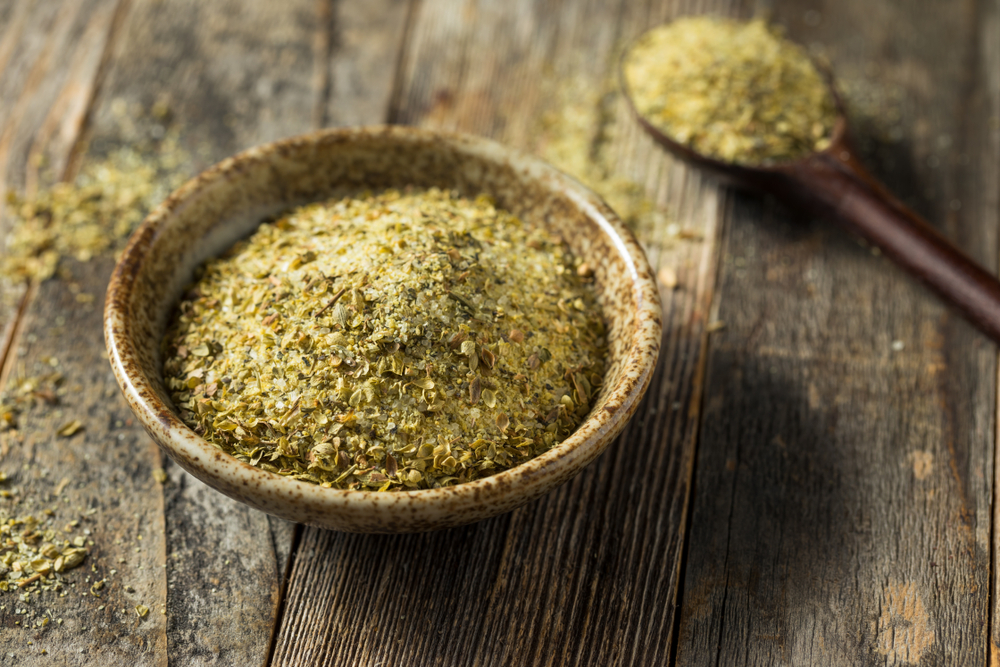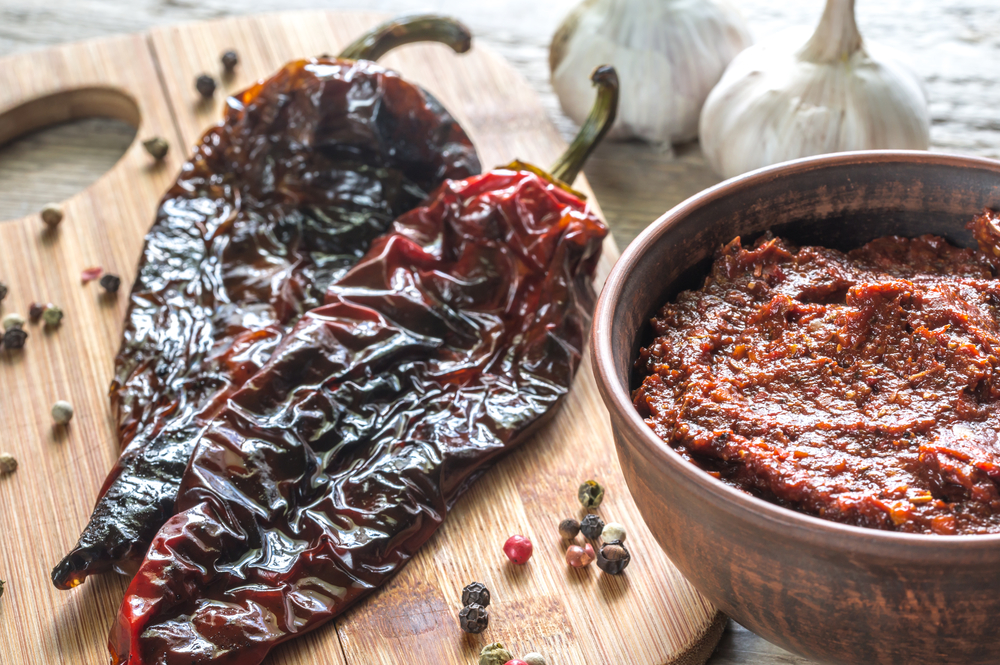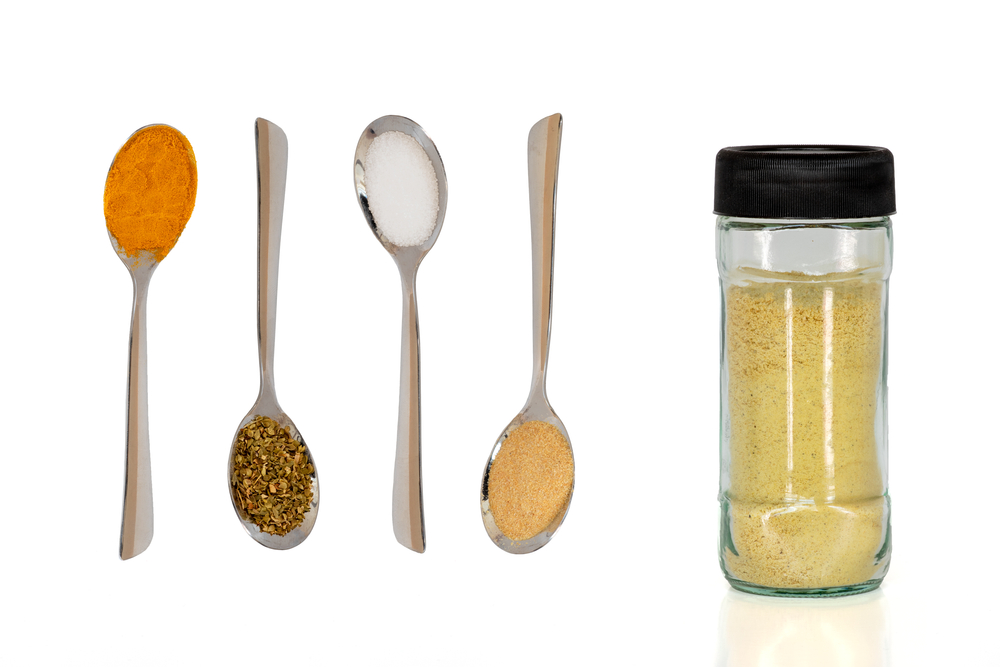Adobo can be a stew, sauce, or paste. But adobo seasoning is mainly associated with the all-purpose dry spice blend featuring salt, pepper, garlic powder, turmeric and oregano. It is widely available in supermarkets under the Goya brand name, or you can make your own to customize the flavor.
What Is Adobo Seasoning?
Adobo seasoning is a mixture of dried spices used as a seasoning salt or rub.
Its name is coined from the Spanish word “adobar,” which means to marinate.
It improves the flavor of your stews, sauté dishes, and meats.
You can find the standard dry adobo seasoning at a grocery store. Look for it in the spices, international foods, or Latin foods sections.
The affordable Goya blend often comes in semi-opaque plastic bottles. You can quickly make adobo seasoning in your kitchen if you can’t find it in the store.

What Are The Ingredients In Adobo Seasoning?
Dry adobo seasoning has a flavor profile that consists of these main ingredients:
- Garlic
- Salt
- Oregano
- Turmeric
- Black pepper
Goya brand also makes several other versions of adobo seasoning with additional ingredients:
- With pepper
- Without pepper
- Bitter orange
- Cumin
- Hot
- Coriander and anatto
- Lemon and pepper
- Saffron
- Less sodium (with and without pepper)
Does Adobo Seasoning Have MSG?
Yes and no!
Several companies that manufacture and sell adobo seasoning add MSG to their seasoning mix. MSG may be included in the list with other ingredients, such as tricalcium phosphate, an anticaking agent, dyes, and other unspecified ‘spices’ and ‘flavors.’
Other manufacturers do not include MSG in their adobo seasoning.
MSG (monosodium glutamate) has been used for roughly 100 years as a flavor enhancer. It’s naturally present in certain foods. However, it is also a common additive in some recipes, soups, canned vegetables, and processed goods.
In 2012, the FDA certified MSG safe for human consumption. However, some people choose to avoid it because it can cause headaches.
If you want to avoid MSG, always check the list of ingredients on the label, or make your own adobo at home.
Is Adobo The Same As Seasoning Salt?
Adobo is a mixture of Spanish or Latin spices that enhances the flavor of many foods.
The American all-purpose seasoned salt is similar, except it contains different ingredients, such as paprika, sugar, and onion powder. It’s not the same, but the two could be substituted for one another.
What Does Adobo Seasoning Taste Like?
Adobo seasoning has a classic savory and earthy flavor.
It is zesty, salty, aromatic, tangy, and complex, usually with a strong garlic flavor. Blends with chili powder will have the addition of spicy heat.
In the mixes that use turmeric or annato, adobo will also give your food a golden tinge and earthy flavor.
There are two main types of adobo seasoning: dry and wet.
Dry adobo seasoning
Dry adobo seasoning imparts a savory flavor to nearly any type of food. It is common in Mexican and Filipino dishes, and comes in a convenient shaker bottle, or you can easily make your own at home.
Wet adobo seasoning
Adobo “mojado” uses citrus fruit, like lime and sour oranges. It is more common in Caribbean dishes, and it’s harder to find in stores. Wet adobo uses the classic ingredients of adobo with the addition of olive oil, vinegar, and fresh garlic. Traditionally, to make a wet adobo seasoning, you need a mortal and pestle to pound the ingredients together. Using a garlic press makes the recipe a bit easier.
Other versions of adobo include:
- Mexican adobo seasoning – Mexican adobo is the most common adobo seasoning. The Mexican adobo is full of hot chilis, oregano, and cumin.
- Cuban adobo – Cuban mojo is an adobo made with sour orange juice, garlic, and oregano. It’s popular for marinating pork and chicken. The Cuban mojo adobo seasoning is available in most Latin grocery stores.
- Caribbean adobo – Dry adobo is famous in the Caribbean, especially in Puerto Rico, Dominican Republic, and Venezuela. Use it on nearly any protein, vegetable, rice or potato.
How To Cook With Adobo Seasoning
Most people prefer using the dry adobo over the wet one as it is less likely to burn when grilling. However, for excellent flavor, consider using wet adobo and let the meat marinate for several days before grilling over a low temperature.
Use these tips for using adobo seasoning in:
- Meat – Sprinkle adobo seasoning directly on the meat as you’re searing.
- Beans – Cook Adobo seasoning down into beans.
- Rice – Add adobo seasoning to rice as you’re cooking. You can customize your adobo seasoning by adding turmeric or annato for color, or cumin for flavor.
What Is The Difference Between Adobo And Adobo Seasoning?
The adobo sauce/paste and adobo seasoning each boast a unique way of enhancing the taste of your meals.
As discussed, adobo seasoning is a dry blend of salt, garlic, oregeno and other sprices. It’s extremely versatile and can be added to virtually any food. Other versions of adobo seasoning may include dried citrus zest, turmeric, cumin, saffron, annato, or chili powder.
Adobo sauce may include all of the traditional ingredients plus a blend of oil, vinegar, tomatoes, sugar/honey, fresh citrus juice/zest, and a paste made from dried chilis like guajillo, chipotle, or ancho. The final consistency may be a thick paste-like for wet rub applications or a runny marinade.

Adobo Seasoning Versus Sazon
In Puerto Rican, the Dominican Republic, Mexican, and other Latin American cookeries, adobo and sazon are both pantry staples.
They start with the same base, but sazon typically has several ingredients added for color, such as paprika, turmeric, annato and sometimes yellow food coloring. It’s also more common to find MSG in sazon.
How To Make Your Own Adobo
Check out this recipe for a classic adobo seasoning.
You can add 1/2 teaspoon of each of these optional ingredients to customize your own adobo blend:
- Paprika
- Cumin
- Annato
- Turmeric
- Saffron
- Dried citrus zest
- Chili powder
How To Prevent Adobo From Caking
Ensure you keep your adobo away from heat or steam in a tightly sealed jar.
Shake up the jar to break up any clumps that may have formed during the storage period.
You can also add a few grains of rice to the bottle to absorb moisture, and some home chefs even swear by adding up to 10% cornstarch and mixing thoroughly.

